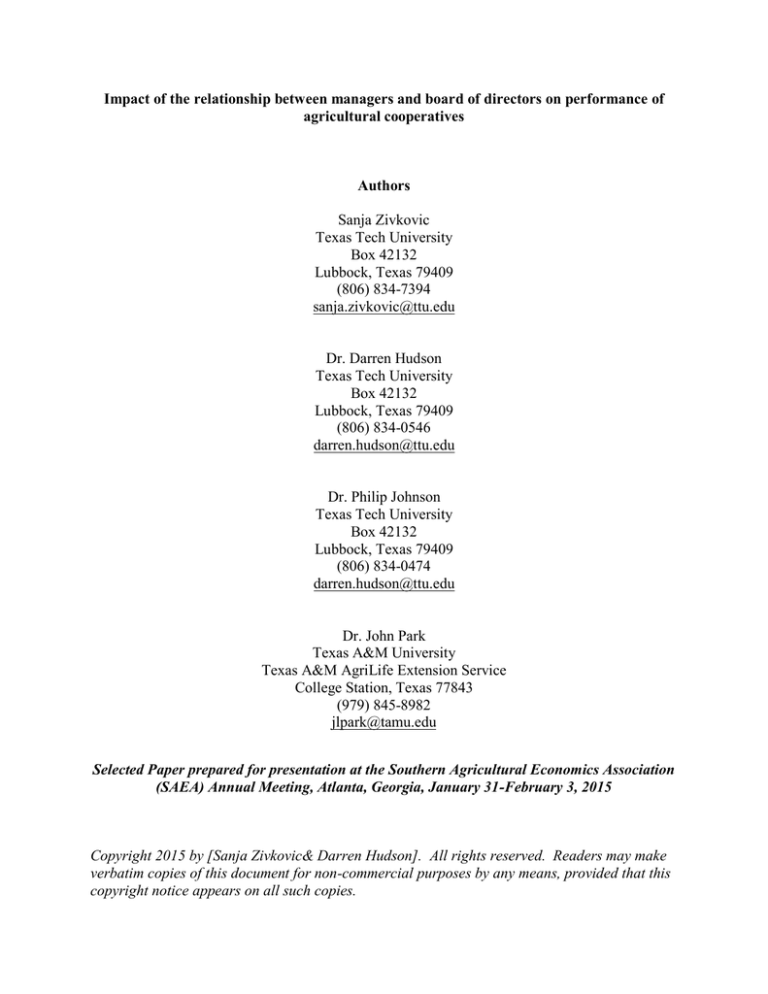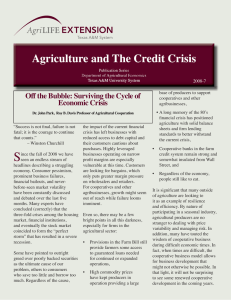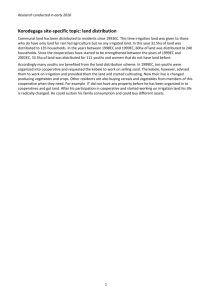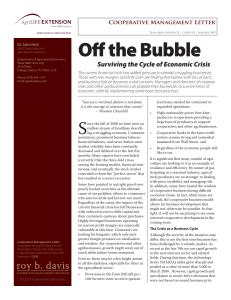Impact of the relationship between managers and board of directors on... agricultural cooperatives
advertisement

Impact of the relationship between managers and board of directors on performance of agricultural cooperatives Authors Sanja Zivkovic Texas Tech University Box 42132 Lubbock, Texas 79409 (806) 834-7394 sanja.zivkovic@ttu.edu Dr. Darren Hudson Texas Tech University Box 42132 Lubbock, Texas 79409 (806) 834-0546 darren.hudson@ttu.edu Dr. Philip Johnson Texas Tech University Box 42132 Lubbock, Texas 79409 (806) 834-0474 darren.hudson@ttu.edu Dr. John Park Texas A&M University Texas A&M AgriLife Extension Service College Station, Texas 77843 (979) 845-8982 jlpark@tamu.edu Selected Paper prepared for presentation at the Southern Agricultural Economics Association (SAEA) Annual Meeting, Atlanta, Georgia, January 31-February 3, 2015 Copyright 2015 by [Sanja Zivkovic& Darren Hudson]. All rights reserved. Readers may make verbatim copies of this document for non-commercial purposes by any means, provided that this copyright notice appears on all such copies. Abstract Cooperatives operate under a business model that creates unique challenges in financial management, governance, strategy, and communication. There have been a number of efforts to identify challenges, critical issues and success factors for agricultural cooperatives. One of the issues agricultural cooperatives are facing is the relationship between managers and the board of directors. Directors in a cooperative occupy a crucial position between members and hired management. Acting as a group, directors set the objectives for the cooperative and decide what the cooperative will do while the general manager decides how it can best be done, subject to board review. Success of a cooperative mainly depends on good board/ manager relationships. This study was focused on evaluation of impact of the relationship between the board of directors and managers on performance of agricultural cooperatives. Data originated from a mail survey and personal interviews among managers and chairmen of agricultural cooperatives in Texas. The results showed that size of the cooperative had negative impact on performance while more frequent engagement of the managers in strategic planning, higher level of managers’ job satisfaction, and organizational commitment positively affect the profitability of a cooperative. Key words: agricultural cooperatives in Texas; managers; board of directors; relationship; performance; job satisfaction; strategic planning. 1 1. Introduction Cooperatives are a significant part of the U.S. economy and are particularly predominant in the agricultural sector (Kenkel and Park, 2011). A cooperative is a user-owned and user-controlled business that allocates benefits on the basis of use. A cooperative operates mainly to provide benefits to members through transactions and through a distribution of patronage earnings from these transactions. Members are required to provide equity capital (ownership) and exercise member control (governance). The business model of cooperatives creates unique challenges, which have encouraged agricultural economists to analyze these challenges, critical issues, and success factors for agricultural cooperatives (Kenkel and Park, 2011). One of the issues agricultural cooperatives are faced is the relationship between managers and the board of directors. Directors in a cooperative occupy a crucial position between members and hired managers who are selected by the board. Acting as a group, directors set the objectives for the cooperative and decide what the cooperative will do while the general manager decides how it can best be done, subject to board review. Contrary to investor-oriented firms (IOFs), cooperatives are owner controlled firms because producers are the owners/members and the board of directors is elected, from the membership, by the members to be their representatives in the management process. Directors need to adjust to the needs and wants of patrons as they are patrons of the business as well, which is usually not the case for IOF board members (Cobia, 1989). Making decisions about what goals to pursue and how best to achieve them is the essence of cooperative management. The role of managers’ behavior is seen as an increasingly interesting theoretical research area and there is a growing recognition about relevance of management in the study of agricultural cooperatives. Managers or agents are not recognized as important or even actual participants in cooperative organizational behavior (Cook et al., 2004). Although the role of management behavior in the performance of agricultural cooperatives is seen as an interesting theoretical research area, it received limited attention from management science, organizational behavior, and economics researchers. The roles and behavior of the general manager of a user-controlled firm (agricultural cooperative) differ from those of the manager of an investor-oriented-firm (IOF) (Cook, 1994). A successful manager of a user oriented firm, besides the skills of an IOF business leader, needs to acquire four additional 2 qualifications. First, managers need to be comfortable with vagueness, complexity, and conflict. Second, managers need to concentrate more planning efforts on developing entrepreneurial and operating abilities rather than on portfolio-related objectives. Third, communication and leadership skills are important and becoming a professional spokesperson for members is an imperative. Finally, the cooperative leader must be comfortable with building coalitions, consensus, and inter-member loyalty-key components in developing group cohesiveness. The effectiveness of management is one of the most important factors in determining the success or failure of any firm, whether it be a cooperative or an investor oriented firm (IOF). Both the board of directors and the managers are involved in the cooperative management process and activities such as: planning, organizing, directing, staffing, and controlling. The working relationship between the board and the general manager requires respect and an understanding of each other's responsibilities (Cobia, 1989). They both need to understand their responsibilities and authorities and they need to work together as a team in order for a cooperative to be successful (Cobia, 1989). Therefore, success of a cooperative mainly depends on good board/ manager relationships. 2. Conceptual framework In the 1990’s output in the area of theoretical research on the economics of agricultural cooperatives was increased significantly (Cook et al., 2004) and researchers were exploring variables that affect performance of cooperatives. Based on findings from literature review, performance might be affected by various variables and some of them are included in the model of this study. Sharing and effective use of information generally enhances productivity of the firm as well its performance. The board needs to be able to set the limits within which management will perform which is why communication is very important in terms of objectives, ideas, concerns and setting goals between the board and the managers. The board needs to keep managers adequately informed about cooperative plans, policies, and strategies. Management problems arise from a lack of teamwork, cooperation or communication among the board, members and managers 3 (Cobia, 1989). Given the importance of communication we would hypothesize that communication is directly related to cooperatives’ performance. Size is another variable that might affect the performance of a cooperative. Previous research (Zvi and Parliament, 1990) examined size effect on financial performance and results showed that small regional cooperatives have higher profitability while large regional cooperatives are more efficient through economies of scale. Although the trend among cooperatives is to expand through mergers and acquisition, results of this study specify that higher efficiency of asset utilization does not mean higher profitability. Strategic planning is considered a very important variable and it represents one of the critical issues to the continued success of cooperatives (Boland et al., 2011). In order to assist managers and directors in evaluating strategy it is necessary to understand better the competitive environment for all firms in an industry. Additional talent and education on this topic are crucial for director and manager leadership development. Because of its importance, strategic planning is included in the model of this study in order to determine its effect on performance. Performance in relation to organizational commitment and job satisfaction has received considerable attention in past research (Darwish, 2000). There are reasons to believe that there are likely to be strong feedback effects between organizational commitment and cooperatives’ performance. A decline in employees’ commitment is one reason for the decreasing market share and poor financial performance of a number of organizations (Fulton and Giannakas, 2001). We believe that if managers are highly committed to their cooperatives and highly satisfied with their jobs, the performance will be high as well. Based on findings from literature review, it is apparent that researchers shed light into cooperatives’ performance and variables that influence it. However, the relationship between managers and the board of directors in agricultural cooperatives has not yet been explored. The main objective of this study was to evaluate the relationship between managers and the board of directors, from the managers’ perspective, and examine the effect of the following variables: communication, size, managers’ engagement in strategic planning, job satisfaction, and organizational commitment on performance of a cooperative. 4 3. Materials and Methods A survey was conducted among two parties, the general managers and the chairmen (as representatives of the board of directors) in 148 agricultural cooperatives in Texas. Because focus was on both the general manager and the chairman of the same cooperative, there were 296 questionnaires (148 for managers and 148 for chairmen). In order to enhance the awareness of this study and thus increase the number of participants, this research was presented at the Texas Agricultural Cooperative Council (TACC) Managers Conference held July 9-11, 2014 in Ruidoso, New Mexico and the TACC Board Conference held July 23-25, 2014 in Ruidoso, New Mexico. At these two conferences all details about this study were clarified to potential participants. After the conferences, two questionnaires, one for the general manager and another one for the board chairman were sent via mail to 148 agricultural cooperatives. Some of the questions in these two questionnaires were different; they were adjusted to two different pools of participants. The questionnaire for the general manager and a self-addressed, postage paid envelope were placed into one envelope and were mailed to the general manager. The questionnaire for the board chairman and a self-addressed, postage paid envelope were placed into another envelope and were mailed to the chairman of the same cooperative. The general manager filled out the questionnaire for the general manager while the chairman filled out the questionnaire for the board chairman of the same cooperative. The manager and the chairman separately mailed the questionnaires back in the self-addressed, postage paid envelopes. The managers and the chairmen from cooperatives in the Lubbock area were personally interviewed in their cooperatives, instead of mailing out the survey. Appointments were scheduled with both the general manager and the chairman of the same cooperative and they were interviewed at their cooperative. In order to protect confidentiality and privacy of participants, the interviews were placed at different times so that one party was not able to hear the answers of the other party. Therefore, there were four different participant pools with two different data collection methods. First, Texas agriculture cooperative managers completed a hard copy of a manager survey. 5 Second, Texas agriculture cooperative chairmen completed a hard copy of a chairman survey. Third, county of Lubbock agriculture cooperative managers were personally interviewed. Fourth, county of Lubbock agriculture cooperative chairmen were personally interviewed. The interview questions were the same as survey questions and the answers to the interview questions were collected by asking questions to the participants and writing down their answers on the questionnaire. Model-testing approach This study was designed to evaluate the impact of size, strategic planning, job satisfaction, communication, and commitment of managers on financial performance of agricultural cooperatives. Two models (equation 1) were estimated, in which dependent variables differed, while independent variables were the same. Models: 𝑅𝑒𝑡𝑢𝑟𝑛 𝑜𝑛 𝑖𝑛𝑣𝑒𝑠𝑡𝑚𝑒𝑛𝑡 / 𝑅𝑒𝑡𝑢𝑟𝑛 𝑜𝑛 𝑒𝑞𝑢𝑖𝑡𝑦 = 𝛼 + 𝛼1 𝑠𝑖𝑧𝑒 + 𝛼2 𝑠𝑡𝑝𝑙𝑎𝑛 + 𝛼3 𝑐𝑜𝑚𝑝 + 𝛼4 𝑗𝑜𝑏𝑠𝑎𝑡 + 𝛼5 𝑐𝑜𝑚𝑚 + 𝛼6 𝑜𝑟𝑔𝑐𝑚𝑡 + 𝛼7 𝑐𝑎𝑟𝑒𝑒𝑟 + 𝜖 (1) Return on investment represented dependent variable in model 1, while return on equity represented dependent variable in model 2. The financial ratios of all the cooperatives were calculated from their audited annual reports for each year during the period 2011 to 2013. Both financial ratios were derived as the mean for this three year period. Independent variables were the same in both models: size = the current number of full-time employees in a cooperative, stplan = frequency of engagement in strategic planning, comp = satisfaction with compensation and benefits, jobsat = overall satisfaction with job, comm = satisfaction with quality of communication, orgcmt = number of conferences and meetings attended per year, career = belief that a manager will spend the rest of his career with the cooperative, and 𝜖 = error term. 4. Results and discussion The survey was sent to 148 agricultural cooperatives in Texas thus there were 296 individuals: 148 managers and 148 chairmen. Totally, 76 individuals filled out the survey, 46 managers (42 6 males and 4 females) and 30 chairmen. The managers’ response rate was 31% while the chairmen response rate was 20%. The majority of the cooperatives (60%) were service (cotton gin) cooperatives while the remaining 40% included production, marketing, and supply (purchasing) cooperatives. Although data was collected from both the managers and the chairmen, this study was mainly focused on analysis of managers’ data and examination of managers’ perception about their relationship with the board of directors. The responses from the chairmen will be examined in our future study in which there will be a group of 60 individuals, 30 managers and 30 chairmen. The responses from each manager will be paired with the responses of the chairman from the same cooperative and their relationship will be explored as well as the effect of their relationship on the performance of a cooperative. Descriptive analysis of data for the managers Table 1 shows that 37% of the 46 managers were older than 56 years, 30% were between 51 and 55 years old, 7% were between 46 and 50 years old, 11% were between 41 and 45 years old, and the remaining 15% of the managers were between 25 and 40 years old. Table 1. Age of the managers who participated in survey Age 25-30 Number of managers in % 4% 31-35 36-40 41-45 46-50 51-55 ≥56 7% 4% 11% 7% 30% 37% As shown in the Table 2, most of the managers, 37% completed an undergraduate degree, 28% accomplished some college, 20% completed high school, and 15% earned a graduate degree. Table 2. Education level of the managers who participated in survey Education High school Some college Undergraduate Graduate Number of managers in % 20% 28% 37% 15% Table 3 shows information about the frequency of official and unofficial meetings with the board. While 85% of the managers meet once a month officially with the board, the remaining 7 15% meet once every few months. Compared to official meetings, 39% of the managers meet once a week to discuss cooperatives business, 50% of the managers meet once a month unofficially with the board chairman, 9% meet once every few months while the remaining 2% do not meet unofficially. Table 3. The frequency of official and unofficial meetings with the board of directors Frequency of meetings Officially Unoficially Once a week Once a month 0% 39% 85% 50% Once every Once every Once a year few months few years 15% 9% 0% 0% 0% 0% Never 0% 2% Responses to the question about strategic planning (Table 4) showed that 43% of the managers engaged in strategic planning with the board once a year, 20% of the managers engaged once every five years, 21% never engaged in strategic planning, while the remaining 15% engaged in strategic planning once every three to five years. Table 4. The frequency of managers’ engagement in strategic planning Frequency of engagement in strategic planning Number of managers in % Once a year Once every two years Once every three years Once every five years Never 43% 7% 9% 20% 21% The managers were asked to rank (from 1 to 6) the following six items in order of importance (1 being the most important): customer service/product quality, capital improvement, employee retention, profitability/patronage refunds, attracting new members, and stock retirement (Table 5). The results showed that: 82% of the managers responded that the customer service/product quality was the most important item. Managers reported employee retention and profitability/patronage refunds equally important. Capital improvement ranked fifth, while attracting new members and stock retirement were listed as the least important items. 8 Table 5. Ranking each of the following items in order of importance Ranking Customer service/Product quality 1st Employee retention 2nd Profitability/Patronage refunds 2nd Capital improvement 5th Attracting new members 6th Stock retirement 6th One part of the survey contained questions related to communication between managers and the board of directors. The results showed that the managers’ average satisfaction level with the amount of communication was 8.7 on scale from 1 to 10, while the average satisfaction level with the quality of communication was 8.8 (Table 6). Table 6. Average satisfaction level of managers on scale from 1 to 10 Average satisfaction level with: Scale from 1 to 10 Amount of communication 8.7 Quality of communication 8.8 Job 9.1 Business relationship with the board 9.1 In order to examine job satisfaction, the managers were asked how they felt about their fulfillment and performance. The results showed that 89% of the managers felt high fulfillment and high performance, 2% felt high fulfillment but low performance, 7% felt low fulfillment and high performance while the remaining 2% felt low fulfillment and low performance (Table 7). The average satisfaction level (the extent to which the managers were overall satisfied with their job) was 9.1 on scale from 1 to 10 (Table 6). 9 Table 7. Fulfillment and performance of managers Performance Fulfilment High Low High 89% 2% Low 7% 2% With respect to organizational commitment, 46% of the managers stated that they attended 1 to 2 managers’ conferences per year, 30% attended more than 5 conferences, 17% attended 3 to 4 conferences per year, while the remaining 7% of the managers never attended a conference (Table 8). In addition to organizational commitment, 70% of the managers planned to spend the rest of their careers as employees of the cooperative they were working for, while the remaining 30% were not certain about their career. Furthermore, 93% of the managers believed that cooperative had a mission that they believed in and to which they were committed. Table 8. Number of conferences attended per year Number of conferenced attended per year Number of managers in % None 1-2 3-4 ≥5 7% 46% 17% 30% The last part of the survey contained questions related to the relationship between the managers and the board of directors (Table 9). Most of the managers (83%) believed that the nature of the business relationship between them and the board was adult-adult, 11% believed that this relationship was principal-agent, 4% described their relationship as parent-child relation, while 2% stated they had other type of relationship with the board. In addition to this part of the survey, managers were asked whether they felt limited control over the cooperative but total responsibility for the results. More than half, 65% of the managers did not feel limited control over the cooperative, 26% sometimes felt limited control and 9% of the managers felt they had limited control over the cooperative but total responsibility for the results. 10 Table 9. Types of relationship between the managers and the board of directors Board Adult Principal Parent Other Manager Adult Agent Child Number of managers in % 83% 11% 4% 2% Characteristics that managers valued the most about their board chairman were (in order of importance): 1. Trustworthiness, 2. Understanding and respect of the board-manager relationship, 3. A chairman’s total commitment and dedication to the cooperative, 4. Good communication and, 5. Very active and strong experience of the chairman. However, the majority of the managers agreed that their chairmen needed to spend more time for strategic planning. The managers also needed for chairman to come to the chairman’s conferences and encourage other board members to get training. Finally, the managers found it very important that their chairmen determined direction and long term goals. Lastly, the results showed that the average satisfaction level with the overall business relationship between the managers and the board was 9.1 on scale from 1 to 10 (Table 6). Two econometrics models were used to estimate the effect of independent variables on financial ratios as dependent variables. In both cases, double bounded Tobit model was performed in statistical software SAS 9.4 in order to obtain estimates and marginal effects. 11 Table 10. Results for Model 1 (dependent variable=return on investment) Label Size Stplan Comp Jobsat Comm Orgcmt Career Independent variable meaning Size Strategic planning Satisfaction with compensation Job satisfaction Communication Organizational commitment Career Marginal effect -0.00127 0.01259 0.00480 0.02811 -0.00067 0.01338 0.04244 Standard error 0.00077 0.00847 0.00956 0.01732 0.01161 0.01474 0.02268 P value 0.0204 0.1367 0.6153 0.1043 0.935 0.3637 0.0612 Table 11. Results for Model 2 (dependent variable=return on equity) Label Size Stplan Comp Jobsat Comm Orgcmt Career Independent variable meaning Size Strategic planning Satisfaction with compensation Job satisfaction Communication Organizational commitment Career Marginal effect -0.00175 0.02424 0.00512 0.05223 0.00127 0.02017 0.07038 Standard error 0.00128 0.01402 0.01583 0.02866 0.01922 0.02440 0.03755 P value 0.0563 0.0836 0.7461 0.0682 0.9474 0.4082 0.0607 Results for model 1 showed that three variables were significant at 90% level: size, job satisfaction and career while one variable strategic planning was significant at 86%. Results for model 2 showed that the same four variables were statistically significant at 90% level. In both models, the variable size had negative marginal effect while other variables positively affected return on investment and return on equity. One of the explanations for the negative marginal effect of the variable size is that although larger cooperatives improve efficiency through economies of scale, the higher efficiency of asset utilization does not translate into higher profitability. While the large cooperatives may enjoy scale economies in terms of efficiency and they are perceived to be more efficient in employing their assets to generate sales, the small cooperatives have higher profitability and liquidity (Zvi and Parliament,1990). Variable strategic planning had positive marginal effect on both return on investment and return on equity. The more frequently managers engage in strategic planning, the higher the probability to increase profitability. Variable job satisfaction had positive marginal effect on profitability as well. The larger the extent to which managers are satisfied with their job, the higher the 12 probability of increasing both ratios. Likewise, the variable career positively affected both dependent variables explaining that if a manager is willing to spend the rest of his career in the cooperative, his commitment, dedication and loyalty will positively affect profitability of the cooperative as he will put more effort in both his own performance and cooperative’s performance. 5. Conclusion Agricultural cooperatives can improve their probability of being successful by addressing the inherently important issues affecting their performance. Communication is one of the major challenges and responsibilities of both the cooperative board and management. Effective communication about their interests and objectives as well as cooperation between members can improve the probability of success. Effectively managed and well controlled cooperative with satisfied and committed members has the best chance of developing into viable business that is able to generate the expected benefits for all members. There are likely to be strong feedback effects between member commitment and cooperatives’ performance (Fulton and Giannakas, 2001). The unique structure and ownership of the cooperative requires effective communication with member owners and users of the cooperative. It is the management of human capital as well as the relations among members and managers, which is perceived as the most important determinant of company performance. 13 References Cobia, David W. “Cooperatives in agriculture.” Englewood Cliffs, NJ: Prentice-Hall, 1989. Print. Darwish A. Yousef, (2000),"Organizational commitment: a mediator of the relationships of leadership behavior with job satisfaction and performance Fulton, Murray, and Konstantinos Giannakas. "Organizational Commitment in a Mixed Oligopoly: Agricultural Cooperatives and Investor-Owned Firms." American Journal of Agricultural Economics. 83.5 (2001): 1258-1265. Web, 5 February, 2014. <http://ajae.oxfordjournals.org/content/83/5/1258.extract>. Kenkel, Phil and John Park. "Theme Overview: Critical Issues for Agricultural Cooperatives." Choices: The Magazine of Food, Farm, and Resource Issues. (2011): n. page. Web, 26 February, 2014. <http://www.choicesmagazine.org/choices-magazine/theme-articles/critical-issues-foragricultural-cooperatives/theme-overview-critical-issues-for-agricultural-cooperatives>. Zvi, Lerman and Claudia Parliament. “Size and industry effects in the performance of agricultural cooperatives”. Agricultural Economics. 6 (1991): 15-29. Web, 3 February, 2014. <http://www.sciencedirect.com/science/article/pii/016951509190013B 14






